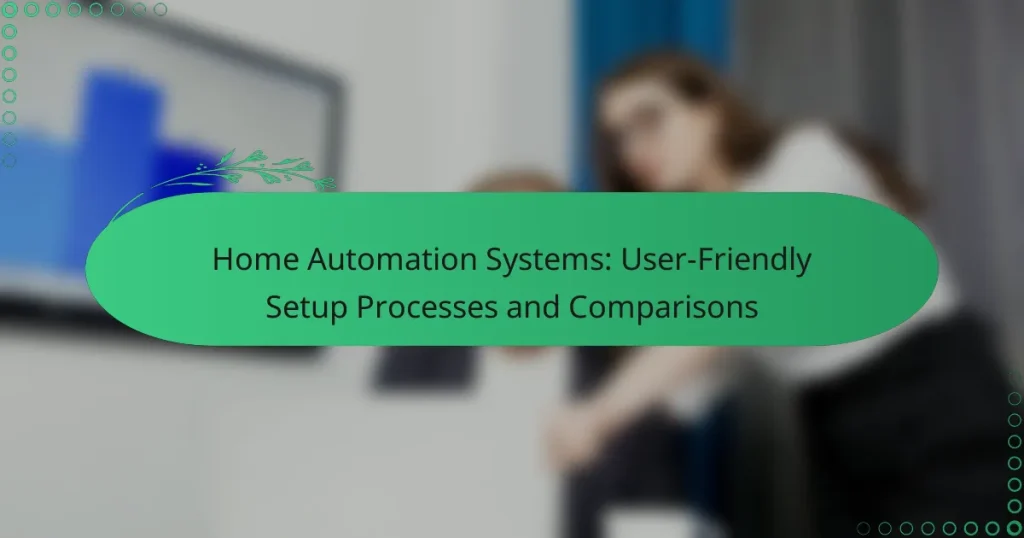Home automation systems have revolutionized the way we interact with our living spaces, offering user-friendly setup processes that make connecting and controlling devices effortless. With options like Google Nest Hub, Amazon Echo Plus, and Samsung SmartThings, users can easily install and configure their smart devices through intuitive apps, enhancing convenience and efficiency. When choosing a system, it’s essential to consider factors such as device compatibility, user interface, and security features to ensure a seamless integration into your home.
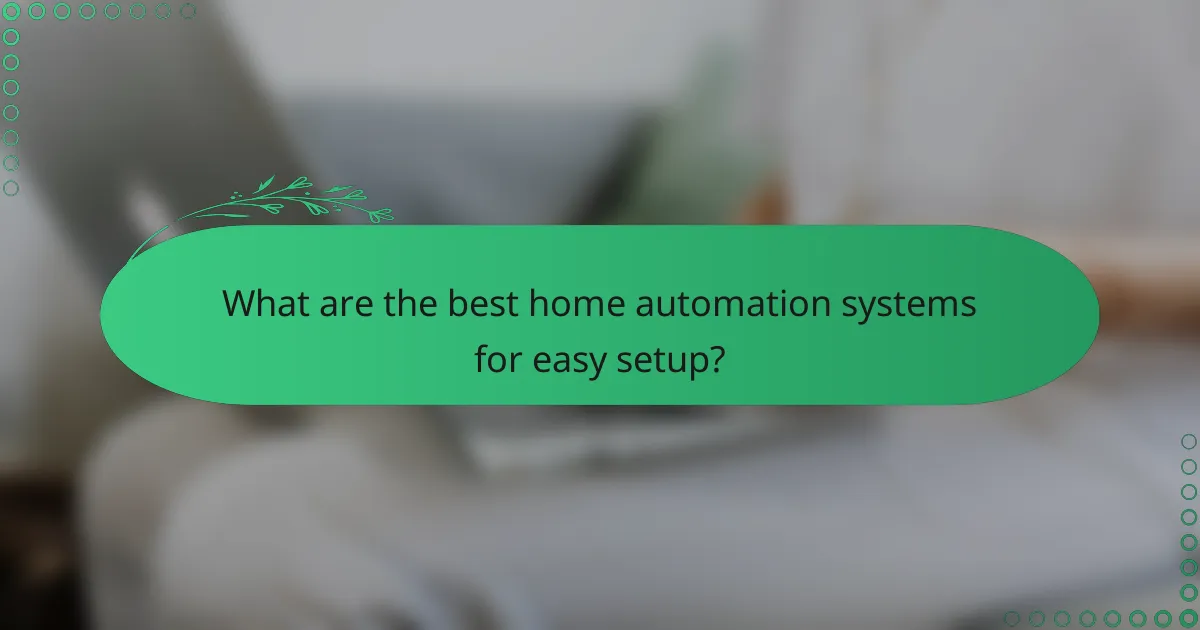
What are the best home automation systems for easy setup?
The best home automation systems for easy setup are designed to be user-friendly, allowing users to connect and control devices with minimal effort. Key options include Google Nest Hub, Amazon Echo Plus, Samsung SmartThings, Apple HomePod, and Wink Hub 2, each offering unique features and straightforward installation processes.
Google Nest Hub
The Google Nest Hub is known for its intuitive interface and seamless integration with Google services. Setting it up typically takes just a few minutes, as it connects to your Wi-Fi and guides you through the process via voice prompts.
Consider using the Nest Hub to control compatible smart devices, such as lights and thermostats, through voice commands or the touchscreen. It supports a wide range of devices, making it a versatile choice for home automation.
Amazon Echo Plus
The Amazon Echo Plus combines a smart speaker with a built-in Zigbee hub, simplifying the connection of compatible smart devices. Setup is straightforward, often requiring only a few steps through the Alexa app.
This system allows users to control devices using voice commands or the app, making it easy to manage home automation. The Echo Plus is particularly beneficial for those already invested in the Amazon ecosystem.
Samsung SmartThings
Samsung SmartThings offers a comprehensive platform for home automation, supporting a wide array of devices from different manufacturers. The setup process involves downloading the SmartThings app and following the on-screen instructions, which is generally user-friendly.
SmartThings is ideal for users looking to create complex automation routines, as it allows for extensive customization. However, ensure that your devices are compatible with the SmartThings ecosystem to maximize its potential.
Apple HomePod
The Apple HomePod is designed for users within the Apple ecosystem, providing easy integration with iOS devices. Setup is quick and can be done through the Home app on your iPhone or iPad, often taking just a few minutes.
This system excels in controlling HomeKit-compatible devices, allowing for voice control via Siri. If you are already using Apple products, the HomePod can enhance your smart home experience significantly.
Wink Hub 2
The Wink Hub 2 is a versatile hub that supports various protocols, making it compatible with a wide range of smart devices. Its setup process is user-friendly, typically requiring only a few steps to connect to your home network and add devices through the Wink app.
This hub is suitable for users looking for flexibility in their home automation setup. However, be aware that some features may require a subscription for full functionality, so consider your long-term needs before committing.
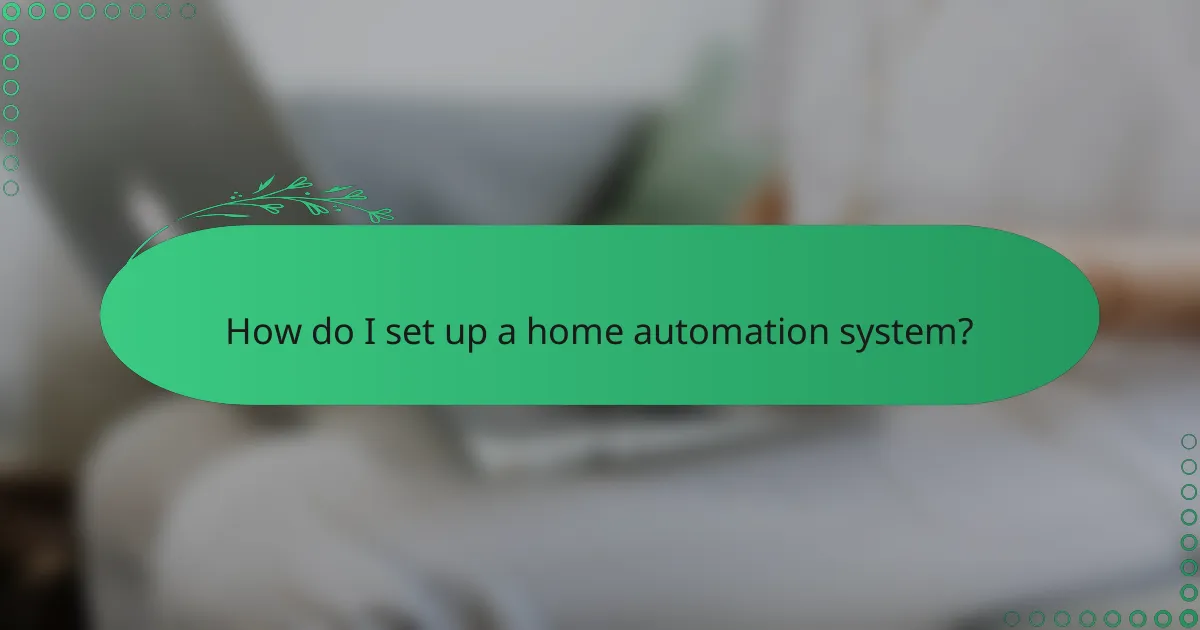
How do I set up a home automation system?
Setting up a home automation system involves selecting a central hub, installing compatible devices, connecting to Wi-Fi, and configuring settings through an app. This process allows you to control various smart devices from a single interface, enhancing convenience and efficiency in your home.
Step 1: Choose a central hub
The central hub is the brain of your home automation system, coordinating communication between devices. Popular options include Amazon Echo, Google Nest Hub, and Samsung SmartThings, each offering unique features and compatibility with various devices.
When selecting a hub, consider factors such as device compatibility, ease of use, and the range of supported protocols like Zigbee or Z-Wave. Ensure the hub can integrate with the devices you plan to use for a seamless experience.
Step 2: Install compatible devices
After choosing a hub, the next step is to install devices that work with it. Common devices include smart lights, thermostats, security cameras, and smart locks. Check the specifications to confirm compatibility with your selected hub.
Installation typically involves following the manufacturer’s instructions, which may include mounting devices and connecting them to power. Ensure that you place devices within range of the hub for optimal performance.
Step 3: Connect to Wi-Fi
Connecting your hub and devices to Wi-Fi is crucial for remote access and control. Most hubs will guide you through the connection process via their app. Ensure you have a stable internet connection, as this will affect the responsiveness of your automation system.
For best results, use a dual-band router that supports both 2.4 GHz and 5 GHz frequencies. The 2.4 GHz band often provides better range, while the 5 GHz band offers faster speeds for devices located close to the router.
Step 4: Configure settings via app
Once everything is connected, use the hub’s app to configure settings and create automation routines. This may include setting schedules, adjusting device settings, or creating scenes that control multiple devices simultaneously.
Take advantage of features like voice control or geofencing, which can enhance your automation experience. Regularly check for software updates to ensure your system remains secure and functional.
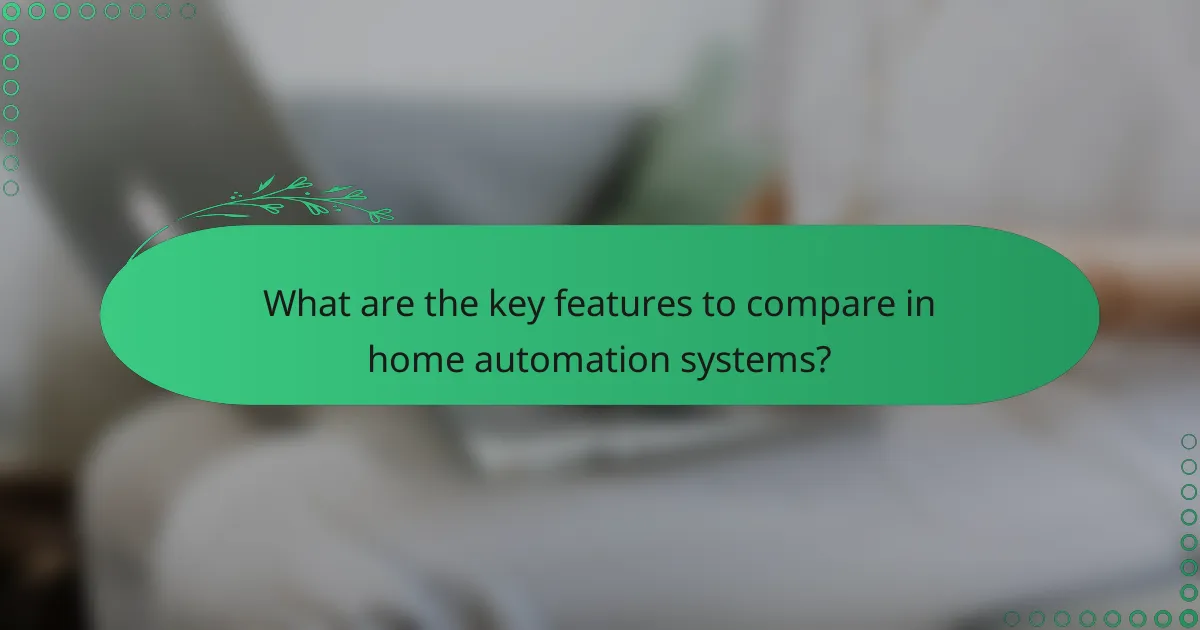
What are the key features to compare in home automation systems?
When comparing home automation systems, focus on device compatibility, user interface, voice control options, and security features. These elements significantly influence how well the system integrates into your home and meets your needs.
Device compatibility
Device compatibility refers to how well the home automation system works with various smart devices, such as lights, thermostats, and security cameras. Look for systems that support a wide range of brands and protocols like Zigbee, Z-Wave, or Wi-Fi to ensure seamless integration.
Consider the number of devices you plan to connect. Some systems may support dozens of devices, while others may be limited to a handful. Always check the manufacturer’s specifications to avoid compatibility issues.
User interface
The user interface (UI) is crucial for ease of use. A well-designed UI allows you to control your home automation system effortlessly, whether through a mobile app, web portal, or physical control panel. Look for intuitive layouts and clear navigation.
Test the UI before purchasing if possible. Some systems offer demo versions of their apps, which can provide insight into how user-friendly they are. A responsive and visually appealing interface can enhance your overall experience.
Voice control options
Voice control options enable hands-free operation of your home automation system, making it convenient to manage devices. Popular platforms like Amazon Alexa, Google Assistant, and Apple HomeKit offer varying levels of integration, so check which ones are supported.
Consider the effectiveness of voice recognition and the range of commands available. Some systems may allow for complex routines, while others might only support basic functions. Choose a system that aligns with your voice control preferences.
Security features
Security features are essential for protecting your home automation system from unauthorized access. Look for systems that offer end-to-end encryption, two-factor authentication, and regular software updates to safeguard your data.
Evaluate the system’s ability to monitor and alert you of suspicious activity. Features like motion detection, camera integration, and remote access can enhance your home’s security. Prioritize systems with robust security measures to ensure peace of mind.
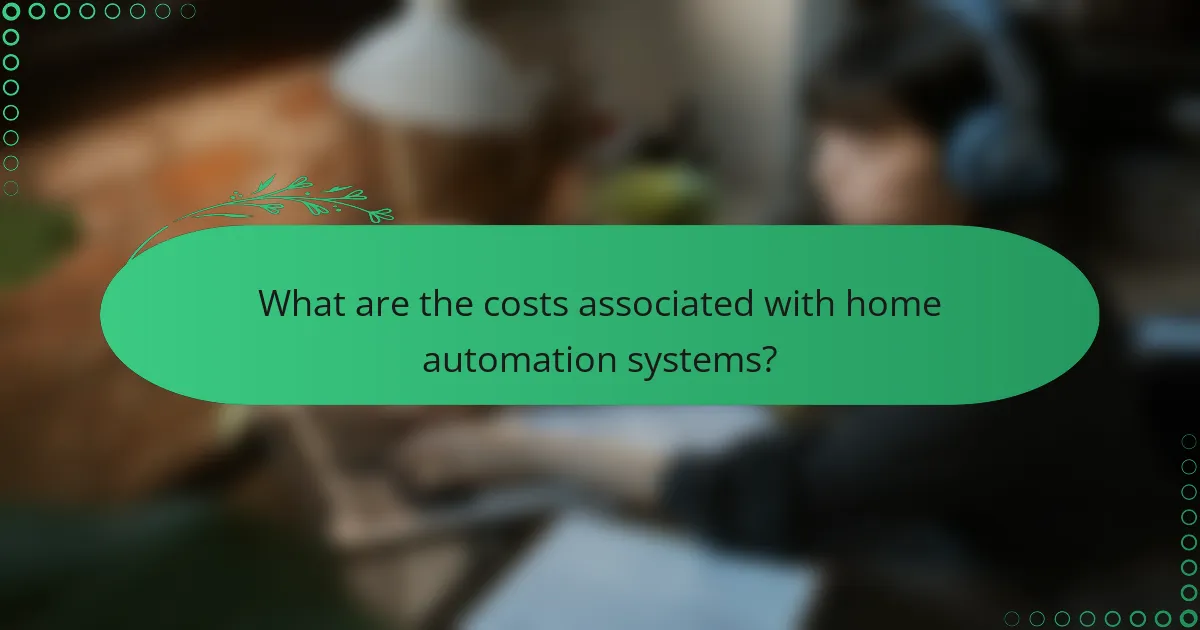
What are the costs associated with home automation systems?
The costs associated with home automation systems can vary widely based on the complexity of the setup and the specific devices chosen. Generally, expenses can be categorized into initial setup costs, monthly subscription fees, and ongoing maintenance expenses.
Initial setup costs
Initial setup costs for home automation systems typically range from a few hundred to several thousand dollars, depending on the number of devices and the sophistication of the system. Basic systems may include smart lights and plugs, while advanced setups could involve security cameras, smart thermostats, and integrated home hubs.
When budgeting for initial costs, consider both hardware and installation fees. Some users opt for DIY installations to save money, while others may hire professionals, which can significantly increase expenses.
Monthly subscription fees
Many home automation systems come with monthly subscription fees, particularly those that offer cloud services, remote monitoring, or advanced features. These fees can range from around $5 to $30 per month, depending on the services provided.
Before committing to a subscription, evaluate what features are essential for your needs. Some systems offer free basic services, while premium features may require additional payments, so it’s wise to compare options.
Maintenance expenses
Maintenance expenses for home automation systems can include software updates, battery replacements, and occasional repairs. While many devices are designed for longevity, users should budget for potential replacements or upgrades every few years.
To minimize maintenance costs, choose reputable brands known for reliability and customer support. Regularly check for software updates and replace batteries as needed to ensure optimal performance of your home automation system.
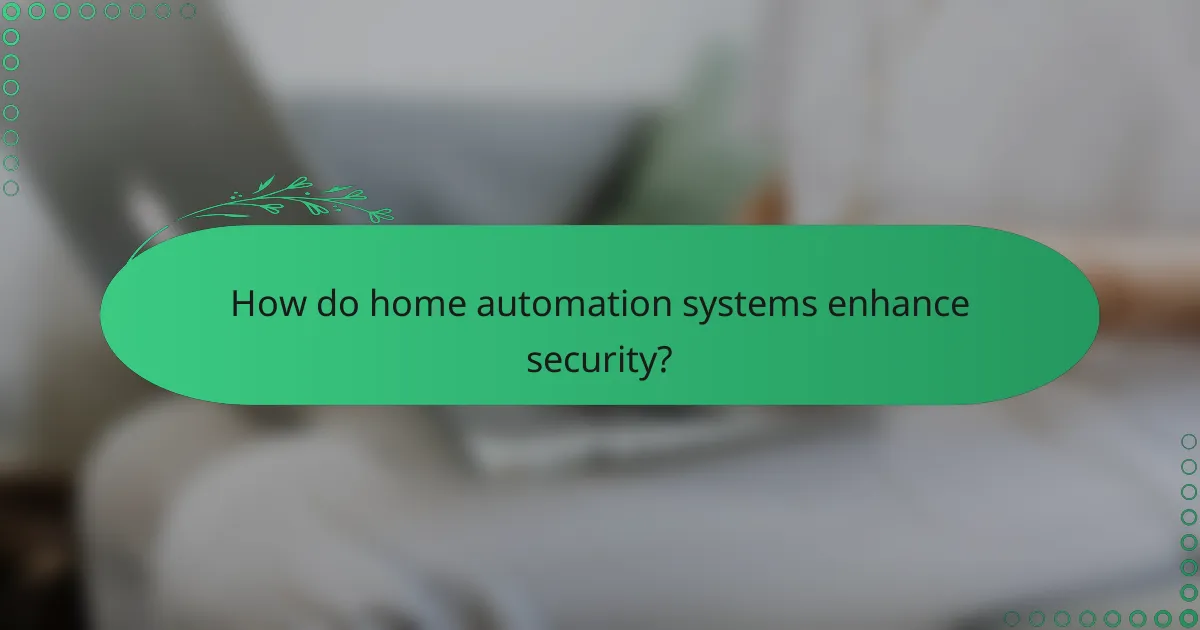
How do home automation systems enhance security?
Home automation systems enhance security by integrating various smart devices that monitor and control access to your home. These systems provide real-time alerts, remote monitoring, and automated responses to potential threats, making it easier to protect your property.
Smart cameras
Smart cameras are essential components of home security systems, allowing homeowners to monitor their property remotely. They typically feature high-definition video, night vision, and motion detection capabilities, which can alert you to unusual activity.
When selecting smart cameras, consider factors such as field of view, storage options, and integration with other devices. Popular models may offer cloud storage plans ranging from free to monthly fees, depending on the features you need.
Automated locks
Automated locks enhance home security by allowing you to control access remotely. These locks can be locked or unlocked via smartphone apps, providing convenience and peace of mind when you’re away from home.
When choosing automated locks, look for features like keyless entry, temporary access codes for guests, and integration with your home automation system. Ensure the locks comply with local security standards to maximize safety.
Motion sensors
Motion sensors play a crucial role in home security by detecting movement and triggering alerts or actions. They can be used to activate cameras, lights, or alarms, providing an immediate response to potential intruders.
When installing motion sensors, consider the placement to avoid false alarms from pets or passing vehicles. Many systems allow you to customize sensitivity settings, ensuring that you receive alerts only when necessary.
